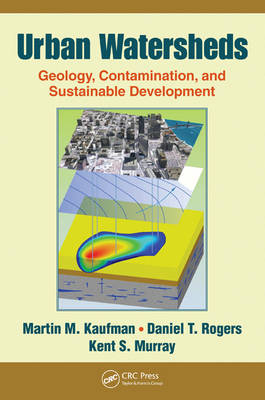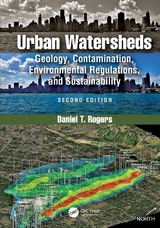
Urban Watersheds
Crc Press Inc (Verlag)
978-1-4398-5274-3 (ISBN)
- Titel erscheint in neuer Auflage
- Artikel merken
The book presents over 20 years of research and professional practice on urban watersheds from the fields of environmental geology, geochemistry, risk analysis, hydrology, and urban planning. The geological characteristics of urbanized watersheds along with the properties of their common contaminants are integrated to assess risk factors for soil, groundwater, and air. With a framework rooted in scientific knowledge, the authors demonstrate the benefits of scientifically informed planning and decision making, offering guidelines to improve watershed management practices as well as urban development and redevelopment practices.
Suitable for use as a textbook and as a professional practice reference, the book includes case studies on successful and unsuccessful approaches to contaminant remediation as well as practical methods for environmental risk assessment. PowerPoint® presentations of selected portions of the book are available with qualifying course adoption.
Martin M. Kaufman is a professor of earth science at the University of Michigan-Flint. He has over 25 years of experience in geographic information systems, hydrologic investigations, and watershed management. Daniel T. Rogers is currently the director of environmental affairs at Amsted Industries Incorporated. Throughout his career, Rogers has managed and conducted hundreds of geologic and hydrogeologic investigations and remediated and successfully closed industrial sites in the United States and internationally. Kent S. Murray is a professor of geology at the University of Michigan-Dearborn. He has over 35 years experience in environmental geology, groundwater hydrology, and low-temperature geochemistry.
The Watershed Approach
Historical Transformation of Urbanized Watersheds by Industrial Development
The Evolution of Industry and the Rouge Watershed
Major Themes of the Watershed Approach Used in This Book
Organization of This Book
PART I: GEOLOGY
Geology of Urban Watersheds
Geological Processes Affecting Urban Watersheds
Sedimentary Processes: From Removal to Rock Formation
Identification and Classification of Sedimentary Deposits
Sedimentary Depositional Environments
Disturbance
Water and the Hydrogeology of Watersheds
Water Basics
Surface Water in Watersheds
Groundwater in Watersheds
Fundamental Concepts of Groundwater
Surface Water–Groundwater Interaction
Anthropogenic Influences on Surface Water and Groundwater
Conducting Subsurface Environmental Investigations in Urban Watersheds
Types and Description of Subsurface Environmental Investigations, Studies, Plans, or Reports
Common Environmental Sampling Methods
Urban Geologic Mapping
Geologic Mapping in an Urban Environment
Geologic Vulnerability
Subsurface Vulnerability and Vulnerability Map Development
Methods
Map-Building Example
Demonstrating the Significance of Vulnerability Mapping
PART II: CONTAMINATION
Common Contaminants in Urban Watersheds
Contaminant Toxicity
Volatile Organic Compounds
Polynuclear Aromatic Hydrocarbons
Polychlorinated Biphenyls
Semivolatile Organic Compounds
Heavy Metals
Other Contaminants
Contaminant Fate and Transport
Contaminant Releases into the Environment
Principles of Contaminant Fate and Transport
Fate and Transport of Contaminants
Metal Contamination in Urban Watersheds
Heavy Metals in Soil
Case Study: Metals in Soil, Rouge River Watershed
Case Study: Dissolved Metals in Shallow Groundwater, Rouge River Watershed
Contaminant Risk Factors
Surface Risk Factor
Groundwater Contaminant Risk Factor
Soil Contaminant Risk Factor
Air Contaminant Risk Factor
Discussion and Implications
Remediation: Techniques and Cost
Remediation Overview
Common Soil Remediation Technologies
Summary of Soil Remediation Technologies
Common Groundwater Remediation Technologies
Summary of Groundwater Remediation Technologies
Sediment Remediation
Surface Water Remediation
Air Remediation
Cost of Remediation
PART III: SUSTAINABLE DEVELOPMENT
Urbanization and the Disruption of Matter and Energy Flows within Watersheds
Watershed Structure
Watershed Function
Urbanization and Watersheds: Disruption of Matter and Energy Flows
Pollution Prevention
Pollution Prevention in the United States
Implementing Pollution Prevention Techniques: Industrial Point Sources
Implementing Pollution Prevention Techniques for Nonpoint Sources in Urbanized Watersheds
Case Studies: Successful and Unsuccessful Redevelopment of Contaminated Sites
Case Study 1: Michigan
Case Study 2: Illinois
Case Study 3: Indiana
Case Study 4: Wisconsin
Case Study 5: California
Case Study 6: New Jersey
Science-Based Landscape Planning in Urban Watersheds
The Science: Policy Gap
Science-Based Landscape Planning
Watershed Management
Attaining Sustainable Urban Watersheds
Sustainability and Sustainable Development
A Framework for Beginning Urban Watershed Management
Linking the First Step to the Big Picture
Glossary of Terms
Index
| Zusatzinfo | 16 page color insert - follows page 204; 50 equations; 86 Tables, black and white; 26 Illustrations, color; 358 Illustrations, black and white |
|---|---|
| Verlagsort | Bosa Roca |
| Sprache | englisch |
| Maße | 178 x 254 mm |
| Gewicht | 1225 g |
| Themenwelt | Naturwissenschaften ► Biologie ► Ökologie / Naturschutz |
| Naturwissenschaften ► Geowissenschaften ► Geologie | |
| Naturwissenschaften ► Geowissenschaften ► Hydrologie / Ozeanografie | |
| Technik ► Umwelttechnik / Biotechnologie | |
| ISBN-10 | 1-4398-5274-X / 143985274X |
| ISBN-13 | 978-1-4398-5274-3 / 9781439852743 |
| Zustand | Neuware |
| Informationen gemäß Produktsicherheitsverordnung (GPSR) | |
| Haben Sie eine Frage zum Produkt? |
aus dem Bereich



